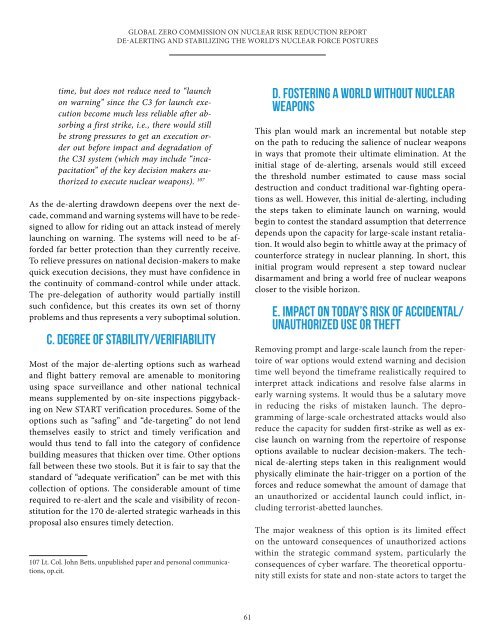global_zero_commission_on_nuclear_risk_reduction_report
global_zero_commission_on_nuclear_risk_reduction_report
global_zero_commission_on_nuclear_risk_reduction_report
Create successful ePaper yourself
Turn your PDF publications into a flip-book with our unique Google optimized e-Paper software.
GLOBAL ZERO COMMISSION ON NUCLEAR RISK REDUCTION REPORTDE-ALERTING AND STABILIZING THE WORLD’S NUCLEAR FORCE POSTUREStime, but does not reduce need to “launch<strong>on</strong> warning” since the C3 for launch executi<strong>on</strong>become much less reliable after absorbinga first strike, i.e., there would stillbe str<strong>on</strong>g pressures to get an executi<strong>on</strong> orderout before impact and degradati<strong>on</strong> ofthe C3I system (which may include “incapacitati<strong>on</strong>”of the key decisi<strong>on</strong> makers authorizedto execute <strong>nuclear</strong> weap<strong>on</strong>s). 107As the de-alerting drawdown deepens over the next decade,command and warning systems will have to be redesignedto allow for riding out an attack instead of merelylaunching <strong>on</strong> warning. The systems will need to be affordedfar better protecti<strong>on</strong> than they currently receive.To relieve pressures <strong>on</strong> nati<strong>on</strong>al decisi<strong>on</strong>-makers to makequick executi<strong>on</strong> decisi<strong>on</strong>s, they must have c<strong>on</strong>fidence inthe c<strong>on</strong>tinuity of command-c<strong>on</strong>trol while under attack.The pre-delegati<strong>on</strong> of authority would partially instillsuch c<strong>on</strong>fidence, but this creates its own set of thornyproblems and thus represents a very suboptimal soluti<strong>on</strong>.C. DEGREE OF STABILITY/VERIFIABILITYMost of the major de-alerting opti<strong>on</strong>s such as warheadand flight battery removal are amenable to m<strong>on</strong>itoringusing space surveillance and other nati<strong>on</strong>al technicalmeans supplemented by <strong>on</strong>-site inspecti<strong>on</strong>s piggybacking<strong>on</strong> New START verificati<strong>on</strong> procedures. Some of theopti<strong>on</strong>s such as “safing” and “de-targeting” do not lendthemselves easily to strict and timely verificati<strong>on</strong> andwould thus tend to fall into the category of c<strong>on</strong>fidencebuilding measures that thicken over time. Other opti<strong>on</strong>sfall between these two stools. But it is fair to say that thestandard of “adequate verificati<strong>on</strong>” can be met with thiscollecti<strong>on</strong> of opti<strong>on</strong>s. The c<strong>on</strong>siderable amount of timerequired to re-alert and the scale and visibility of rec<strong>on</strong>stituti<strong>on</strong>for the 170 de-alerted strategic warheads in thisproposal also ensures timely detecti<strong>on</strong>.107 Lt. Col. John Betts, unpublished paper and pers<strong>on</strong>al communicati<strong>on</strong>s,op.cit.D. FOSTERING A WORLD WITHOUT NUCLEARWEAPONSThis plan would mark an incremental but notable step<strong>on</strong> the path to reducing the salience of <strong>nuclear</strong> weap<strong>on</strong>sin ways that promote their ultimate eliminati<strong>on</strong>. At theinitial stage of de-alerting, arsenals would still exceedthe threshold number estimated to cause mass socialdestructi<strong>on</strong> and c<strong>on</strong>duct traditi<strong>on</strong>al war-fighting operati<strong>on</strong>sas well. However, this initial de-alerting, includingthe steps taken to eliminate launch <strong>on</strong> warning, wouldbegin to c<strong>on</strong>test the standard assumpti<strong>on</strong> that deterrencedepends up<strong>on</strong> the capacity for large-scale instant retaliati<strong>on</strong>.It would also begin to whittle away at the primacy ofcounterforce strategy in <strong>nuclear</strong> planning. In short, thisinitial program would represent a step toward <strong>nuclear</strong>disarmament and bring a world free of <strong>nuclear</strong> weap<strong>on</strong>scloser to the visible horiz<strong>on</strong>.E. IMPACT ON TODAY’S RISK OF ACCIDENTAL/UNAUTHORIZED USE OR THEFTRemoving prompt and large-scale launch from the repertoireof war opti<strong>on</strong>s would extend warning and decisi<strong>on</strong>time well bey<strong>on</strong>d the timeframe realistically required tointerpret attack indicati<strong>on</strong>s and resolve false alarms inearly warning systems. It would thus be a salutary movein reducing the <strong>risk</strong>s of mistaken launch. The deprogrammingof large-scale orchestrated attacks would alsoreduce the capacity for sudden first-strike as well as exciselaunch <strong>on</strong> warning from the repertoire of resp<strong>on</strong>seopti<strong>on</strong>s available to <strong>nuclear</strong> decisi<strong>on</strong>-makers. The technicalde-alerting steps taken in this realignment wouldphysically eliminate the hair-trigger <strong>on</strong> a porti<strong>on</strong> of theforces and reduce somewhat the amount of damage thatan unauthorized or accidental launch could inflict, includingterrorist-abetted launches.The major weakness of this opti<strong>on</strong> is its limited effect<strong>on</strong> the untoward c<strong>on</strong>sequences of unauthorized acti<strong>on</strong>swithin the strategic command system, particularly thec<strong>on</strong>sequences of cyber warfare. The theoretical opportunitystill exists for state and n<strong>on</strong>-state actors to target the61


